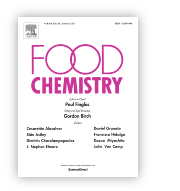
Research papers of the month – January 2023
We present the highest-score research papers of January 2023. These papers have ben published in journals with the highest Ministerial score – 200 points.
Effects of fermentation and enzymatic treatment on phenolic compounds and soluble proteins in oil press cakes of canola (Brassica napus)
Ye Tian; Ying Zhou; Marie Kriisa; Maret Anderson; Oskar Laaksonen; Mary-Liis Kütt; Maike Föste; Małgorzata Korzeniowska; Baoru Yang
Food Chemistry
Ministerial score = 200.0
Journal Impact Factor (2023) = 9.231 (Q1)
 To develop novel processes for valorizing agro-industry side-streams, canola (Brassica napus) oil press cakes (CPC) were treated with lactic acid bacteria, carbohydrase, and protease. Altogether 29 protein-rich liquid fractions were obtained, of which the composition was analyzed using chromatographic and mass spectrometric methods. A clear association was revealed between the treatments and phenolic profile. Applying certain lactic acid bacteria enhanced the release of sinapic acid, sinapine, glycosylated kaempferols, and other phenolic compounds from CPC. Co-treatment using protease and Lactiplantibacillus plantarum was effective in degrading these compounds. The fraction obtained after 16 h of hydrolysis (with Protamex® of 2% dosage) and 48 h of fermentation (using L. plantarum) contained the lowest phenolic content (0.2 g/100 g DM) and a medium level of soluble proteins (78 g/100 g) among all samples studied. The fractions rich in soluble proteins and low in phenolics are potential food ingredients with improved bioavailability and sensory properties.
To develop novel processes for valorizing agro-industry side-streams, canola (Brassica napus) oil press cakes (CPC) were treated with lactic acid bacteria, carbohydrase, and protease. Altogether 29 protein-rich liquid fractions were obtained, of which the composition was analyzed using chromatographic and mass spectrometric methods. A clear association was revealed between the treatments and phenolic profile. Applying certain lactic acid bacteria enhanced the release of sinapic acid, sinapine, glycosylated kaempferols, and other phenolic compounds from CPC. Co-treatment using protease and Lactiplantibacillus plantarum was effective in degrading these compounds. The fraction obtained after 16 h of hydrolysis (with Protamex® of 2% dosage) and 48 h of fermentation (using L. plantarum) contained the lowest phenolic content (0.2 g/100 g DM) and a medium level of soluble proteins (78 g/100 g) among all samples studied. The fractions rich in soluble proteins and low in phenolics are potential food ingredients with improved bioavailability and sensory properties.
DOI:10.1016/j.foodchem.2022.135339
Monitoring the Water Vapor Content at High Spatio-Temporal Resolution Using a Network of Low-Cost Multi-GNSS Receivers
Grzegorz Marut; Tomasz Hadaś; Jan Kapłon; Estera Trzcina; Witold Rohm
IEEE Transactions on Geoscience and Remote Sensing
Ministerial score = 200.0
Journal Impact Factor (2023) = 8.125 (Q1)
 The global navigation satellite system (GNSS) has the capacity for remote sensing of water vapor content in the atmosphere. Post-processing of GNSS data can provide integrated water vapor (IWV) with accuracies comparable to measurements of traditional sensors, i.e., water vapor radiometers. While GNSS meteorology benefits from thousands of permanent GNSS stations operating worldwide the spatial resolution of GNSS-derived IWV is limited to tens of kilometers. Further densification of GNSS networks is achievable with low-cost GNSS receivers. We investigated the feasibility of low-cost multi-GNSS receivers for monitoring IWV. The post-processing and the real-time (RT) solution are validated against: 1) the results from a geodetic-grade GNSS receiver; 2) colocated water vapor radiometer; and 3) numerical weather model (NWM). Despite the high variability of the IWV during the validation period, the standard deviation of IWV differences with respect to the water vapor radiometer was 1.0 and 1.5 kg/ m2 in post-processing and RT, respectively. The city-scale variability of water vapor content in the atmosphere was monitored by a network of 16 low-cost GNSS receivers deployed in the city of Wroclaw, Poland. During rapidly changing weather conditions, the disagreement between the low-cost GNSS-derived IWV field and the NWM reached up to 5.4 kg/ m2 and interstation IWV differences exceeded 5 kg/ m2 . It has been demonstrated that low-cost GNSS receivers are reliable tools for precise determination of IWV, also in RT. This study is the first to measure the water vapor content with a spatial resolution of single kilometers and to present a significantly diversified city-scale IWV field.
The global navigation satellite system (GNSS) has the capacity for remote sensing of water vapor content in the atmosphere. Post-processing of GNSS data can provide integrated water vapor (IWV) with accuracies comparable to measurements of traditional sensors, i.e., water vapor radiometers. While GNSS meteorology benefits from thousands of permanent GNSS stations operating worldwide the spatial resolution of GNSS-derived IWV is limited to tens of kilometers. Further densification of GNSS networks is achievable with low-cost GNSS receivers. We investigated the feasibility of low-cost multi-GNSS receivers for monitoring IWV. The post-processing and the real-time (RT) solution are validated against: 1) the results from a geodetic-grade GNSS receiver; 2) colocated water vapor radiometer; and 3) numerical weather model (NWM). Despite the high variability of the IWV during the validation period, the standard deviation of IWV differences with respect to the water vapor radiometer was 1.0 and 1.5 kg/ m2 in post-processing and RT, respectively. The city-scale variability of water vapor content in the atmosphere was monitored by a network of 16 low-cost GNSS receivers deployed in the city of Wroclaw, Poland. During rapidly changing weather conditions, the disagreement between the low-cost GNSS-derived IWV field and the NWM reached up to 5.4 kg/ m2 and interstation IWV differences exceeded 5 kg/ m2 . It has been demonstrated that low-cost GNSS receivers are reliable tools for precise determination of IWV, also in RT. This study is the first to measure the water vapor content with a spatial resolution of single kilometers and to present a significantly diversified city-scale IWV field.
DOI:10.1109/TGRS.2022.3226631










